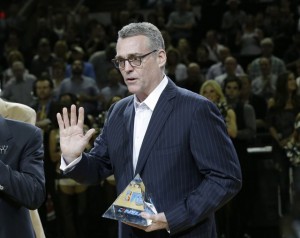San Antonio Spurs’ R.C. Buford proves to be a master builder
By DERON SNYDER
In the end, R.C. Buford was way better than Pat Riley. Their matchup was more lopsided than the last three games in the NBA Finals.
Riley would win soundly in a popularity contest. Many NBA fans don’t know what Buford does for a living and most couldn’t identify him in a lineup.
He didn’t play for the legendary Adolph Rupp at Kentucky or come off the bench (and guard Jerry West in practice) for the Los Angeles Lakers. He didn’t coach the “Showtime” Lakers to four NBA titles or lead the New York Knicks to their first Finals’ in two decades.
And he certainly didn’t build the Miami Heat into a championship team, first by drafting Dwyane Wade and trading for Shaquille O’Neal, later by luring LeBron James and Chris Bosh to South Beach to join Wade.
While Riley was becoming a fashion icon and celebrity coach-turned-executive, Buford was working his way up the San Antonio Spurs organization. He went from assistant coach to head scout to director of scouting to vice president/assistant GM before being elevated to general manager in July 2002.
His handiwork was on display again Sunday night, as the Spurs routed Miami for the third consecutive game and won the club’s fifth NBA title. San Antonio outscored Miami 322-265 in the series, exposing the Heat as a surprisingly thin, limited and poorly-constructed team.
That’s not to go overboard in criticizing Miami. It did plenty right to reach four consecutive NBA Finals and win a pair back-to-back. But the disparity in versatility and overall talent compared to the Spurs is painfully obvious.
For the clearest view of Riley’s deficiency in constructing his roster, subtract the so-called Big Threes. Take away James, Wade and Bosh for Miami. Remove Tim Duncan, Tony Parker and Manu Ginobli for San Antonio.
The discrepancy in leftovers is stark, as embarrassing as the Spurs’ thrashings. It’s the main reason this series was highly uncompetitive.
Two of the Spurs “other” players actually trump two of Miami’s mainstays. NBA Finals MVP Kwahi Leonard is better than Wade and Bosh at this point, while skilled big man Boris Diaw is more valuable than Bosh.
Youngsters Danny Green, Patty Mills and Tiago Splitter have more to offer than Mario Chalmers, Norris Cole and everyone else on Miami’s bench except Ray Allen, who’s still Ray Allen.
So Riley has some explaining to do. He over-relied on Wade, whose physical decline has been painful to witness, and Bosh, who has an annoying habit of shrinking when needed most. Those mistakes compounded Riley’s gaffe of not stocking the roster with enough multi-dimensional role players.
Conversely, Buford assembled the perfect complement of players to support Duncan, Parker and Ginobli. Credit is due to coach Greg Popovich, too, for having the sense (and system) to develop his bench. During the regular season, eight Spurs averaged 20 or more minutes and six averaged double figures in scoring.
The pieces melded seamlessly in the Finals as San Antonio put on a clinic. “It was exquisite basketball,” Miami coach Erik Spoelstra said after Game 5. Bosh said the Spurs “played the best basketball I’ve ever seen.”
James said San Antonio epitomized five working as one. “That’s how team basketball should be played,” he said. “You know, it’s selfless. Guys move, cut, pass. You’ve got a shot, you take it, but it’s all for the team and it’s never about the individual.”
Prior to Game 5, Buford shot down notions that the Spurs’ brand of ball should be the model.
“I don’t know that anybody has the right to determine how the game is supposed to be played,” he told a group of reporters. “You try to play to the strengths of your team and put your players in position to be successful.
“… Everybody has that goal, and their team fits differently. To say, there’s a way that looks beautiful, I don’t know how you even can judge that.”
If he needs clear-cut examples of ugly basketball, he should look at film of Riley’s Knicks.
The Spurs are aesthetically pleasing because Buford’s roster gives Pop options. They attack the rim, launch three-pointers and play in the post, seemingly taking whatever they want instead of what the defense allows. It’s a breath of fresh air in a league where 1-on-1 isolation plays are the standard, where often neither the ball nor other players move very much.
San Antonio’s Big Three has been the constant in four of the Spurs’ five NBA titles. Everything else can be contributed to Buford’s machinations,
“The Spurs continue to get better,” James said after Game 5. “ Obviously, they kept those three guys intact, but they continue to put guys around them – high basketball‑IQ guys around them, high‑energy guys around them – that fit into the system of what Pop wanted to do.”
Riley put together James, Wade and Bosh, no small feat.
But he didn’t do nearly as good a job as Buford in building a supporting cast.
 Follow
Follow

